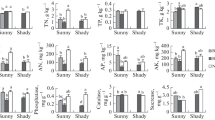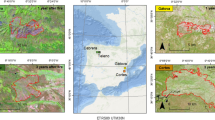Abstract
Fire is an important ecological factor that structures savannas, such as the cerrado, by selecting plant species and altering soil nutrient content. In Emas National Park, central Brazil, we compared soils under three different fire regimes and their relationship to the cerrado species they support. We collected 25 soil and vegetation samples at each site. We found differences in soil characteristics (p < 0.05), with fertility and fire frequency positively related: in the annually burned site we found higher values of organic matter, nitrogen, and clay, whereas in the protected site we detected lower values of pH and higher values of aluminum. We also observed differences in plant community structure, with distinct floristic compositions in each site. Floristic composition was more related to sand proportion (intra-set correlation = 0.834). Different fire frequencies increase environmental heterogeneity and beta diversity in the Brazilian cerrado.


Similar content being viewed by others
Abbreviations
- OM:
-
organic matter
- SB:
-
sum of bases
- CEC:
-
cation exchange capacity
- V:
-
base saturation
- m:
-
aluminum saturation
- CCA:
-
canonical correspondence analysis
References
Amorim PK, Batalha MA (2007) Soil–vegetation relationships in hyperseasonal cerrado, seasonal cerrado and wet grassland in Emas National Park (central Brazil). Acta Oecol 32:319–327
Anderson MJ (2003) NPMANOVA: a Fortran computer program for non-parametric multivariate analysis of variance (for any two-factor Anova design) using permutation tests. Department of Statistics, University of Auckland, New Zealand
Batalha MA, Mantovani W (1999) Chaves de identificação das espécies vegetais vasculares baseada em caracteres vegetativos para a ARIE Cerrado Pé-de-Gigante (Santa Rita do Passa Quatro, SP). Rev Inst Florest 11:137–158
Batalha MA, Martins FR (2002) The vascular flora of the cerrado in Emas National Park (central Brazil). SIDA 20:295–312
Bond WJ, Woodward FI, Midgley GF (2005) The global distribution of ecosystems in a world without fire. New Phytol 165:525–538
Bowker MA, Belnap J, Rosentreter R, Graham B (2004) Wildfire-resistant biological soil crusts and fire-induced loss of soil stability in Palouse prairies, USA. Appl Soil Ecol 26:41–52
Brye KR (2006) Soil physiochemical changes following 12 years of annual burning in a humid-subtropical tallgrass prairie: a hypothesis. Acta Oecol 30:407–413
Camargo-Ricalde SL, Dhillion SS (2003) Endemic Mimosa species can serve as mycorrhizal “resource islands” within semiarid communities of the Tehuacán-Cuicatlán Valley, Mexico. Mycorrhiza 13:129–136
Casals P, Romanya J, Vallejo VR (2005) Short-term nitrogen fixation by legume seedlings and resprouts after fire in Mediterranean old-fields. Biogeochemistry 76:477–501
Coutinho LM (1990) Fire in the ecology of the Brazilian cerrado. In: Goldammer JG (ed) Fire in the tropical biota. Springer, Berlin, pp 81–103
Doerr SH, Cerdà A (2005) Fire effects on soil system functioning: new insights and future challenges. Int J Wildland Fire 14:339–342
Diaz S, Cabido M, Casanoves F (1998) Plant functional traits and environmental filters at a regional scale. J Veg Sci 9:113–122
Dubbin WE, Penn MG, Hodson ME (2006) Edaphic influences on plant community adaptation in the Chiquibul forest of Belize. Geoderma 131:76–88
Embrapa (1997) Manual de métodos de análise do solo. Embrapa, Rio de Janeiro
França H, Ramos-Neto MB, Setzer A (2007) O fogo no Parque Nacional das Emas. Biodiversidade, vol. 27. Ministério do Meio Ambiente, Brasília
González-Pérez JA, González-Vila FJ, Almendros G, Knicker H (2004) The effect of fire on soil organic matter – a review. Environ Int 30:855–870
Goodland R (1971) Oligotrofismo e alumínio no cerrado. In: Ferri MG (ed) III Simpósio sobre o Cerrado. Edgar Blücher, São Paulo. pp 44–60
Gottsberger G, Silberbauer-Gottsberger I (2006) Life in the cerrado: a South American tropical seasonal vegetation, Vol 1: Origin, structure, dynamics and plant use. Reta, Ulm
Haridasan M (2000) Nutrição mineral de plantas nativas do cerrado. Rev Bras Fisiol Veg 12:54–64
Hartnett DC, Potgieter AF, Wilson GWT (2004) Fire effects on mycorrhizal symbiosis and root system architecture in southern African savanna grasses. Afr J Ecol 42:328–337
Hoffman WA (1996) The effects of fire and cover on seedling establishment in a neotropical savanna. J Ecol 84:383–393
Hoffman WA (1998) Post-burn reproduction of woody plants in a neotropical savanna: the relative importance of sexual and vegetative reproduction. J Appl Ecol 35:422–433
Hoffman WA (2002) Direct and indirect effects of fire on radial growth of cerrado savanna trees. J Trop Ecol 18:137–142
Hubbert KR, Preisler HK, Wohlgemuth PM, Graham RC, Narog MG (2006) Prescribed burning effects on soil physical properties and soil water repellency in a steep chaparral watershed, southern California, USA. Geoderma 130:284–298
Jongman RHG, Braak CJF, Tongeren OFR (1995) Data analysis in community and landscape ecology. Cambridge University, Cambridge
Kennard DK, Gholz HL (2001) Effects of high- and low-intensity fires on soil properties and plant growth in a Bolivian dry forest. Plant Soil 234:119–129
Knicker H (2007) How does fire affect the nature and stability of soil organic nitrogen and carbon? A review. Biogeochemistry 85:91–118
Kovach (1999) Multivariate statistical package v.3.1. Kovach Computing Services, Anglesey
Larcher W (1995) Physiological plant ecology. Springer, New York
Manly BFJ (1997) Randomization, bootstrap and Monte Carlo methods in biology. Chapman and Hall, London
Mantovani W, Leitão Filho HF, Martins FR (1985) Chave baseada em caracteres vegetativos para identificação de espécies lenhosas da Reserva Biológica de Moji Guacu, SP. Hoehnea 12:35–66
Milberg P, Lamont BB, Perez-Fernandez MA (1999) Survival and growth of native and exotic composites in response to a nutrient gradient. Plant Ecol 145:125–132
Montgomery RF, Askew GP (1983) Soils of tropical savannas. In: Goodall DW (ed) Ecosystems of the World – tropical savannas. Elsevier, Berlin, pp 63–77
Müller-Dombois D, Ellenberg H (1974) Aims and methods of vegetation ecology. Wiley and Sons, New York
Nardoto GB, Bustamante MMC (2003) Effects of fire on soil nitrogen dynamics and microbial biomass in savannas of Central Brazil. Pesquisa Agropecu Bras 38:955–962
Neff JC, Harden JW, Gleixner G (2005) Fire effects on soil organic matter content, composition, and nutrients in boreal interior Alaska. Can J Res 35:2178–2187
Pivello-Pompéia VR, Coutinho LM (1992) Transfer of macro-nutrients to the atmosphere during experimental burnings in an open cerrado (Brazilian savanna). J Trop Ecol 8:487–497
Pivello VR, Shida CN, Meirelles ST (1999) Alien grasses in Brazilian savannas: a threat to the biodiversity. Biodivers Conserv 8:1281–1294
Raij B, Andrade JC, Cantarella H, Quaggio JA (2001) Análise química para avaliação de fertilidade de solos tropicais. Instituto Agronômico, Campinas
Ramos-Neto MB, Pivello VR (2000) Lightning fires in a Brazilian savanna National Park: rethinking management strategies. Environ Manage 26:675–684
Rhoades CC, Meier AJ, Rebertus AJ (2004) Soil properties in fire-consumed log burnout openings in a Missouri oak savanna. For Ecol Manag 192:277–284
Ruggiero PGC, Batalha MA, Pivello VR, Meirelles ST (2002) Soil–vegetation relationships in cerrado (Brazilian savanna) and semideciduous forest, southeasthern Brazil. Plant Ecol 160:1–16
Scardua FP (2004) Plano de manejo do Parque Nacional das Emas. Ibama, Brasília
Setterfield SA (2002) Seedling establishment in an Australian tropical savanna: effects of seed supply, soil disturbance and fire. J Appl Ecol 39:949–959
Silva FC (1999) Manual de análises químicas de solos, plantas e fertilizantes. Embrapa, Brasília
SMA Secretaria do Estado do Meio Ambiente (1997) Cerrado: bases para conservação e uso sustentável das áreas de cerrado do Estado de São Paulo. SMA, São Paulo
Spera ST, Reatt A, Correia JR, Silva JCS (2000) Características físicas de um latossolo vermelho-escuro no cerrado de Planaltina, DF, submetido à ação do fogo. Pesquisa Agropecu Bras 35:1817–1824
van Wilgen BW, Govender N, Biggs HC, Ntsala D, Funda XN (2004) Response of savanna fire regimes to changing fire-management policies in a large African national park. Conserv Biol 18:1533–1540
van de Vijver CADM, Poot P, Prins HHT (1999) Causes of increased nutrient concentrations in post-fire regrowth in an East African savanna. Plant Soil 214:173–185
Yong-Mei Z, Ning W, Guo-Yi Z, Wei-Kai B (2005) Changes in enzyme activities of spruce (Picea balfouriana) forest soil as related to burning in the eastern Qinghai-Tibetan Plateau. Appl Soil Ecol 30:215–225
Zar JH (1999) Biostatical analysis. Prentice Hall, Upper Saddle River
Acknowledgements
We are grateful to CNPq, for the scholarships granted to both authors; to Fapesp, for financial support; to Ibama, for research permission; to Emas National Park staff, for logistical assistance; to R. Moreira, M.B. Ramos-Neto, and Oréades, for the ENP’s satellite images; to A.T. Fushita, for help in ENP’s fire history map; to P.K. Amorim, C.A. Casali, A.V.F. Jardim, P. Loyola, M. Maia, L.T. Manica, F.Q. Martins, M.V. Cianciaruso, I.A. Silva, L. Sims, for valuable help in field; to M.I.S. Lima, M.V. Cianciaruso and I.A. Silva, for suggestions on the manuscript; to UnB and Unicamp herbaria; and to C. Proença and J. Semir, for their assistance in species identification.
Author information
Authors and Affiliations
Corresponding author
Additional information
Responsible Editor: Tibor Kalapos, Ph.D.
Rights and permissions
About this article
Cite this article
da Silva, D.M., Batalha, M.A. Soil–vegetation relationships in cerrados under different fire frequencies. Plant Soil 311, 87–96 (2008). https://doi.org/10.1007/s11104-008-9660-y
Received:
Accepted:
Published:
Issue Date:
DOI: https://doi.org/10.1007/s11104-008-9660-y




